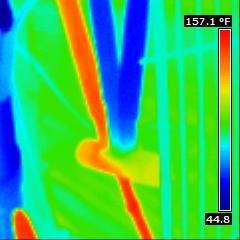John Evans asked: What is the best procedure for testing a heat pump system in sub 60 degree weather? Set in the heat mode, the condenser and evaporator coils are reversing function, correct? In therory, if the heat pump is functional in the heat cycle, it should also function in the cooling cycle.
Opinions?
First, do not test a heat pump in the summertime. The head pressure will become excessive and has a higher probability of damaging an old unit then running an air-conditioner in the winter! There is little pressure differential on the system in the wintertime, but pressures will get excessive in the summer. Not all units have a high pressure safety switch.
You can run the electric heat all you want in the emergency or auxiliary mode setting on the thermostat.
The only component that you cannot assume is working when you assume "it is operating in the heating mode and will also operate in the cooling mode" is the reversing valve.
A heat pump also has a defrost circuit that is a common deficiency for heating mode operation of heat pump.
This is a rather difficult component to test, and I don't think I want to get involved with that test scenario here.
Some things that you may be interested in knowing about the defrost circuit is that the circuit board is basically a timer. It has adjustable time settings (normal settings are about 45 minutes). Every 45 minutes, the circuit board checks a defrost sensor which is a clamp on thermostat attached to the condenser coil. If the temperature of the coil gets below a preset level, the unit assumes that there is ice on the coil. The circuit board enters the defrost mode which does several things. It changes the reversing valve into the air-conditioning mode. It turns on the electric auxiliary heaters so you don't air- condition the interior of the house, and it turns off the out door fan so that the defrost process can occur quickly. The circuit board continues to monitor the defrost sensor (and in some cases a refrigerant pressure switch) and terminates the defrost cycle when a temperature is reached where the unit can assume that all ice and moisture have been removed from the coil.
The defrost design can be more complex than this on higher end units, but this is the basic defrost set up.
On the circuit board, you will see two pins that are labeled "test".
If you place a screwdriver or jumper across the two pins, this will accelerate the timeclock on the circuit board so that instead of a time cycle of 45 minutes, it will cycle in 45 seconds. To perform this test the defrost sensor (a normally open circuit) must be "closed". The circuit will only close when the coil is frozen. So if you jump the test pins and nothing happens, it's because the sensor has not experienced cold enough temperatures to close.
Also, you must remove the screwdriver or jumper as soon as you hear the reversing valve activate. The defrost board has a "timeout" feature to remove the system from defrost in the event of sensor failure. This prevents excessive head pressure and damage to the equipment. This timeout is about two minutes, so in the "accelerated test mode" you only have 2 seconds to remove the jumper or it will go right back into the heating mode.
The test procedure is much more complex than jumping two pins!
I just wanted to let you know how the systems are supposed to operate.
Any testing on the refrigeration circuit should include the use of the refrigeration gauges (for safety). The use of these gauges require EPA certification as there is a possibility to vent refrigerant into the atmosphere.







